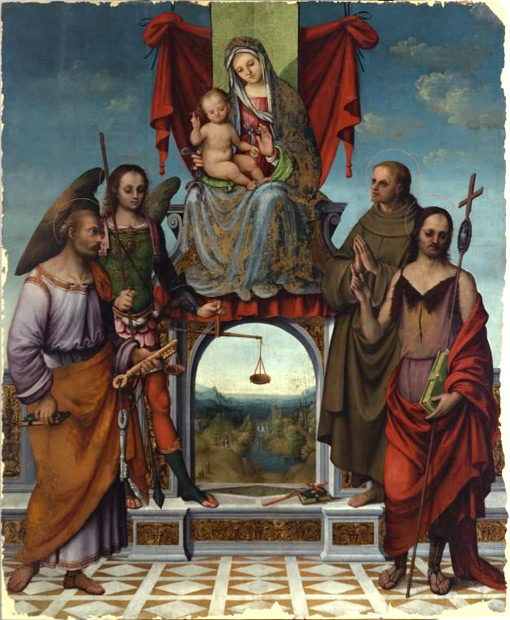Madonna col bambino in trono e santi
Bartolomeo Ramenghi detto il Bagnacavallo senior
(Bagnacavallo 1484 ca. – Bologna 1542 ca.)
Madonna con Bambino in trono con San Michele Arcangelo, San Pietro, San Francesco e San Giovanni Battista
Madonna and Child enthroned between Saints Peter, Michael the Archangel, Francis and John the Baptist
1505-1515 ca.
cm. 200×163 | tempera su tavola | tempera on panel
provenienza: | provenance:
Opere Pie Raggruppate – Bagnacavallo
Vissuto a cavallo tra il XV e il XVI secolo, Bartolomeo Ramenghi, conosciuto anche come il Bagnacavallo senior, è certamente il pittore più rappresentativo della città da cui convenzionalmente ha preso il nome.
E’ probabile che il Ramenghi mosse i suoi primi passi in pittura proprio in ambito bagnacavallese, confrontandosi anche con l’opera degli Zaganelli a Cotignola. Egli tuttavia fu a tutti gli effetti un pittore bolognese, poichè già dal 1503 elesse la città felsinea come luogo della sua formazione e della sua attività artistica. I suoi modelli furono soprattutto il classicismo di Francesco Francia, suo maestro, e la pittura emiliano-ferrarese di Lorenzo Costa. Tra i suoi primi lavori bolognesi va ricordata la sua collaborazione agli affreschi di Santa Cecilia (1506), in stretta collaborazione con Amico Aspertini, da cui trasse numerose suggestioni.
Il Vasari, che tra le sue “Vite” compone anche quella di “Bartolomeo da Bagnacavallo”, riferisce di un viaggio a Roma compiuto dal pittore, dove si sarebbe aggiornato con le ultime prove di Raffaello. Sebbene non documentato, è probabile che il soggiorno nella città papale avvenne nel secondo decennio del secolo. In ogni caso è fuori discussione che la maturazione del suo linguaggio artistico fu stimolata dalla grande diffusione delle opere del maestro urbinate.
Bartolomeo Ramenghi, also known as “Bagnacavallo senior”, lived between the 15th and the 16th centuries and is certainly the most representative painter of the town, from which he also took his name.
Ramenghi probably started his career in town and was aware of the work of the Zaganelli from the near Cotignola. However, he should be considered a Bolognese painter, because from 1503 onwards he trained and worked there. The classicism of Francesco Francia, his teacher, and Lorenzo Costa’s style from Emilia and from Ferrara were Ramenghi’s models. One of his earliest collaborations in Bologna was that of the frescos in Santa Cecilia (1506), where he closely worked with Amico Aspertini, who influenced him in various ways.
The style developed in Santa Cecilia can also be seen in the altarpiece with the Madonna and Child enthroned with Saints (displayed here), possibly painted for the local church of San Giovanni Battista. This early artwork by Ramenghi shows the influence of the Ferrarese Lorenzo Costa, which can be seen in the way perspective is applied to the throne’s representation in order to show the background landscape.
Vasari, whose “Lives” feature also “Bartolomeo da Bagnacavallo”, maintains that Ramenghi had visited Rome, where he caught up with the latest developments of Raphael’s work. Despite lack of actual documentation, the trip to Rome is likely to have occurred during the second decade of the 16th century. The popularity of Raphael’s work certainly contributed to the development of Ramenghi’s artistic style.
Iscriviti alla nostra Newsletter
About Us

Orari di apertura:
giovedì > 10-12 / 15-18
venerdì, sabato e domenica > 10-12 / 15-19



